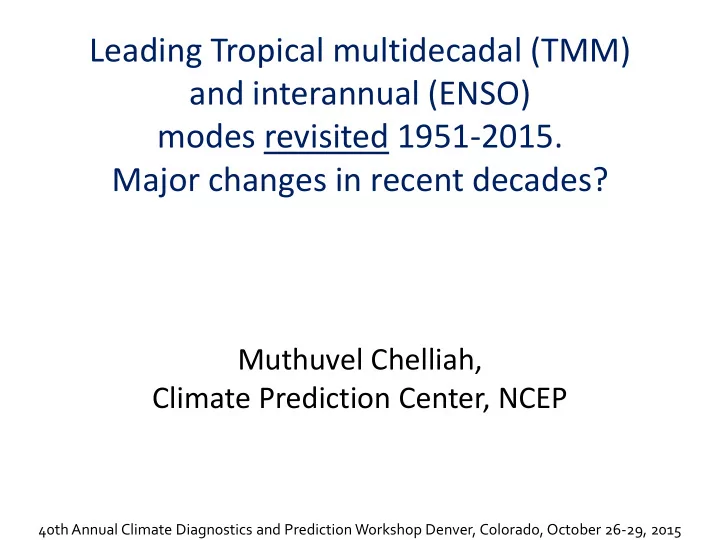

Leading Tropical multidecadal (TMM) and interannual (ENSO) modes revisited 1951-2015. Major changes in recent decades? Muthuvel Chelliah, Climate Prediction Center, NCEP 40th Annual Climate Diagnostics and Prediction Workshop Denver, Colorado, October 26-29, 2015
From: Proceedings of the 23 rd (1998) Annual CDPW, in Miami, FL. Based on reanalysis data beginning 1999, we at NOAA/CPC, along with NHC started issuing its first official seasonal hurricane outlooks.
ENSO
? JJA
83 98 73 58 92 69, 70 78, 80 87,88 95 10 66 TMM ENSO 03, 05 59 64 52,53,54 77 09? 67? 85 74 , 76 06? 71 ,72 ENSO 99, 00 ,01 89 TMM 51,55,56 08 11,12 TMM ENSO
ENSO
? JJA
15 97 65 57 63 72 87 82 09 91,92 51 02 ? 64 89? 11? 54,55 88 70,71 73,75 07? 95? 98 ,99, 00 10
Summary/Key Findings: The two major modes of variability in the global tropics identified in Chelliah and Bell, 2004 during both DJF/JJA • seasons, viz., the Tropical Interdecadal/Multidecadal (TMM) and the ElNino Southern Oscillation (ENSO) modes, are revisited with more recent data up to 2015 (1951-2015). The analysis has identified when and under what circumstances a weak ENSO (El Nino or La Nina) event tends to • strengthen to a moderate or strong event, and when it is not not. In the analysis period considered, 1951-2015: • a) when both modes are positive and in phase, moderate/strong El Ninos (1958, 1973, 1983, 1992, 1998 2010) occurred. (El Nino fizzled in 2014 because TMM was out of phase with ENSO, but it turned favorably in 2015 for a strong El Nino. 2016? ) b) when both modes are negative and are in phase, moderate/strong La Nina events occurred. c) When both modes are of approximately equal amplitude, but of opposite phases, no ENSO events occurred. d) When both modes are of opposite phases, and of uneven amplitudes in strength, the stronger amplitude mode decided the ENSO event. e) 90-95% of all (weak, moderate and strong) ENSO events, and neutral years, can be accounted for by the above phasing/out-of-phasing of the two dominant tropical modes. Coincident with the 1972/73 strong ElNino event, and the change in phase (from –ve to +ve) of the TMM mode, the • tendency for El Nino events to become stronger (and conversely for the relative absence of strong La Ninas) has enhanced. It appears that a shift is highly likely in the phase of the low frequency TMM mode, and the phase change may already be underway coincident with the current ongoing major 2015/16 El Nino event. (Note: This change of phase is a process/slow-adjustment that takes place over the course of a few years!) Ongoing/addnl.work: Extend/Obtain the modes pair for the earlier period (before 1951)–(How if using VPOT from NCEP/R1? ) • Do analyses for the other two seasons SON/MAM as well to get the full annual cycle evolution!! • Explore the predictability issue!! •
Thank you very much for listening !!
Recommend
More recommend